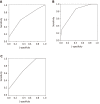Acute gastrointestinal injury in critically ill patients with COVID-19 in Wuhan, China
- PMID: 33132657
- PMCID: PMC7584062
- DOI: 10.3748/wjg.v26.i39.6087
Acute gastrointestinal injury in critically ill patients with COVID-19 in Wuhan, China
Abstract
Background: The coronavirus disease 2019 (COVID-19) is spreading rapidly around the world. Most critically ill patients have organ injury, including acute respiratory distress syndrome, acute kidney injury, cardiac injury, or liver dysfunction. However, few studies on acute gastrointestinal injury (AGI) have been reported in critically ill patients with COVID-19.
Aim: To investigate the prevalence and outcomes of AGI in critically ill patients with COVID-19.
Methods: In this retrospective study, demographic data, laboratory parameters, AGI grades, clinical severity and outcomes were collected. The primary endpoints were AGI incidence and 28-d mortality.
Results: From February 10 to March 10 2020, 83 critically ill patients out of 1314 patients with COVID-19 were enrolled. Seventy-two (86.7%) patients had AGI during hospital stay, of these patients, 30 had AGI grade I, 35 had AGI grade II, 5 had AGI grade III, and 2 had AGI grade IV. The incidence of AGI grade II and above was 50.6%. Forty (48.2%) patients died within 28 days of admission. Multiple organ dysfunction syndrome developed in 58 (69.9%) patients, and septic shock in 16 (19.3%) patients. Patients with worse AGI grades had worse clinical variables, a higher incidence of septic shock and 28-d mortality. Sequential organ failure assessment (SOFA) scores (95%CI: 1.374-2.860; P < 0.001), white blood cell (WBC) counts (95%CI: 1.037-1.379; P = 0.014), and duration of mechanical ventilation (MV) (95%CI: 1.020-1.340; P = 0.025) were risk factors for the development of AGI grade II and above.
Conclusion: The incidence of AGI was 86.7%, and hospital mortality was 48.2% in critically ill patients with COVID-19. SOFA scores, WBC counts, and duration of MV were risk factors for the development of AGI grade II and above. Patients with worse AGI grades had a higher incidence of septic shock and 28-d mortality.
Keywords: COVID-19; Critically ill; Gastrointestinal injury; Organ dysfunction; Septic shock.
©The Author(s) 2020. Published by Baishideng Publishing Group Inc. All rights reserved.
Conflict of interest statement
Conflict-of-interest statement: The authors declare no conflicts of interest.
Figures



Similar articles
-
Clinical course and outcomes of critically ill patients with SARS-CoV-2 pneumonia in Wuhan, China: a single-centered, retrospective, observational study.Lancet Respir Med. 2020 May;8(5):475-481. doi: 10.1016/S2213-2600(20)30079-5. Epub 2020 Feb 24. Lancet Respir Med. 2020. PMID: 32105632 Free PMC article.
-
[Clinical characteristics and prognosis of acute gastrointestinal injury in patients with sepsis-associated acute respiratory distress syndrome].Zhonghua Wei Zhong Bing Ji Jiu Yi Xue. 2024 Jun;36(6):591-596. doi: 10.3760/cma.j.cn121430-20240118-00063. Zhonghua Wei Zhong Bing Ji Jiu Yi Xue. 2024. PMID: 38991957 Chinese.
-
Patient characteristics, clinical course and factors associated to ICU mortality in critically ill patients infected with SARS-CoV-2 in Spain: A prospective, cohort, multicentre study.Rev Esp Anestesiol Reanim (Engl Ed). 2020 Oct;67(8):425-437. doi: 10.1016/j.redar.2020.07.003. Epub 2020 Jul 13. Rev Esp Anestesiol Reanim (Engl Ed). 2020. PMID: 32800622 Free PMC article.
-
Clinical Characteristics and Morbidity Associated With Coronavirus Disease 2019 in a Series of Patients in Metropolitan Detroit.JAMA Netw Open. 2020 Jun 1;3(6):e2012270. doi: 10.1001/jamanetworkopen.2020.12270. JAMA Netw Open. 2020. PMID: 32543702 Free PMC article. Review.
-
Convalescent plasma or hyperimmune immunoglobulin for people with COVID-19: a rapid review.Cochrane Database Syst Rev. 2020 May 14;5(5):CD013600. doi: 10.1002/14651858.CD013600. Cochrane Database Syst Rev. 2020. Update in: Cochrane Database Syst Rev. 2020 Jul 10;7:CD013600. doi: 10.1002/14651858.CD013600.pub2. PMID: 32406927 Free PMC article. Updated.
Cited by
-
Acute Gastrointestinal Injury and Feeding Intolerance as Prognostic Factors in Critically Ill COVID-19 Patients.J Gastrointest Surg. 2022 Jan;26(1):181-190. doi: 10.1007/s11605-021-05015-z. Epub 2021 Apr 27. J Gastrointest Surg. 2022. PMID: 33905039 Free PMC article.
-
A Surgical Perspective of Gastrointestinal Manifestations and Complications of COVID-19 Infection.Gastroenterol Clin North Am. 2023 Mar;52(1):49-58. doi: 10.1016/j.gtc.2022.10.001. Epub 2022 Oct 7. Gastroenterol Clin North Am. 2023. PMID: 36813430 Free PMC article. Review.
-
Integration of human organoids single-cell transcriptomic profiles and human genetics repurposes critical cell type-specific drug targets for severe COVID-19.Cell Prolif. 2024 Mar;57(3):e13558. doi: 10.1111/cpr.13558. Epub 2023 Oct 8. Cell Prolif. 2024. PMID: 37807299 Free PMC article.
-
Trajectories of acute gastrointestinal injury grade in critically Ill children.BMC Pediatr. 2024 Jul 23;24(1):470. doi: 10.1186/s12887-024-04947-0. BMC Pediatr. 2024. PMID: 39044193 Free PMC article.
-
Ace2 and Tmprss2 Expressions Are Regulated by Dhx32 and Influence the Gastrointestinal Symptoms Caused by SARS-CoV-2.J Pers Med. 2021 Nov 16;11(11):1212. doi: 10.3390/jpm11111212. J Pers Med. 2021. PMID: 34834564 Free PMC article.
References
-
- Li Q, Guan X, Wu P, Wang X, Zhou L, Tong Y, Ren R, Leung KSM, Lau EHY, Wong JY, Xing X, Xiang N, Wu Y, Li C, Chen Q, Li D, Liu T, Zhao J, Liu M, Tu W, Chen C, Jin L, Yang R, Wang Q, Zhou S, Wang R, Liu H, Luo Y, Liu Y, Shao G, Li H, Tao Z, Yang Y, Deng Z, Liu B, Ma Z, Zhang Y, Shi G, Lam TTY, Wu JT, Gao GF, Cowling BJ, Yang B, Leung GM, Feng Z. Early Transmission Dynamics in Wuhan, China, of Novel Coronavirus-Infected Pneumonia. N Engl J Med. 2020;382:1199–1207. - PMC - PubMed
-
- World Health Organization. Coronavirus disease (COVID-19) outbreak. Available from: URL: https://www.who.int.
-
- National Health Commission of the People’s Republic of China home page. Available from: URL: http://www.nhc.gov.cn. - PMC - PubMed
MeSH terms
LinkOut - more resources
Full Text Sources

